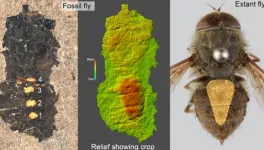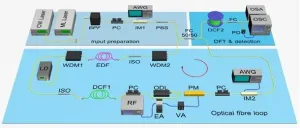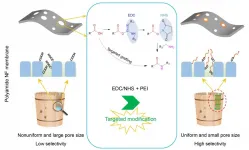Uncovering exotic molecules of potential astrochemical interest
2021-03-11
(Press-News.org) Looking at the night sky, one's thoughts might be drawn to astrochemistry. What molecules inhabit the vast spaces between the stars? Would we see the same molecules that surround us here on Earth? Or would some of them be more exotic--something rarely observed or even unknown?
Recent research by a multinational team led by Prof. Robert Ko?os from the Institute of Physical Chemistry of the Polish Academy of Sciences has revealed an unusual molecule obtained and detected for the first time in laboratory conditions and also paved a smooth path to produce and further study another. Now that they can be seen and studied, they may prove worthy of wider astrochemical interest. Let's get a closer look at this scientific development.
Interstellar clouds - where the story begins...
The medium permeating the space between stars is mainly filled with hydrogen, helium, and cosmic dust. However, average distances between atoms or molecules in these interstellar clouds are so vast that entire days may pass before they collide. In the vacuum of space, the passage of time and the impact of radiation are crucial factors for the development of more advanced chemical compounds.
As the physical conditions found in interstellar clouds are drastically different from those on our planet, the detection of some of the chemical compounds found in them requires advanced studies on Earth. As part of this, scientists create molecules which are normally unstable under Earth conditions and then conduct research on their properties. They discover them on Earth first so that we can more easily detect them in space. Sounds interesting, but how does it look in practice?
Phosphorus menagerie
Jupiter and Saturn have been in the spotlight in our own solar system for more than two decades due to the detection of phosphine (PH3), ammonia's analog, in their atmospheres. In 2020, all eyes shifted towards Venus following claims that PH3 had been found in its atmosphere as well. The appearance of phosphine in an astronomical object is momentous because of its tremendous importance for living organisms. Molecules containing phosphorus are crucial for enzymatic processes which are responsible for the formation of the structural materials of our skeletons, nucleic acids like DNA and RNA, and even energy transport in all living cells. Although it is the 6th most abundant element in Earth's biomass and the 12th most abundant on the planet overall, it is a billion times less abundant in the interstellar medium. Due to their rarity, detecting P-containing molecules in interstellar clouds continues to intrigue scientists.
We know very little about the behavior and existence of P-containing molecules in extreme interstellar conditions. Only a few have been found and are limited to PN, CP, PO, HCP, CCP, PH3, and NCCP. Of these only PO and PN have been detected in molecular clouds. It is possible that the low abundance of reactants containing phosphorus in such media makes the formation of larger molecules quite rare and difficult to detect. We also need to characterize a wider variety of P-containing chemicals so that our search may be expanded to include a larger selection of appropriate targets. The search for new molecules is challenging since many known and promising P-containing species are unstable under typical laboratory conditions.
The IPC PAS researchers: Dr. Arun-Libertsen Lawzer, Dr. Thomas Custer, and Prof. Robert Ko?os, working in collaboration with Prof. Jean-Claude Guillemin of the Ecole Nationale Supérieure de Chimie de Rennes (France) have recently presented an efficient, UV-light-assisted cryogenic synthesis of the HCCP molecule, opening new possibilities for the spectroscopic investigation of this unusual chemical compound. It was detected using infrared and UV-vis spectroscopy. This characterization should be useful for possible future extraterrestrial detections.
"We use ultraviolet to dehydrogenate phosphorus containing organic molecules to produce exotic phosphorus species. We were able to produce triplet HCCP which is a molecule of astrochemical importance. The trick to detecting it lies in using the environment of a frozen inert gas." - remarks Dr. Lawzer.
The experiments performed as part of the project, and relevant theoretical studies show that the molecule has a linear shape and peculiar chemical bonding. Prof. Ko?os comments: "You may have heard in your school days that phosphorus was either 3- or 5-valent in its chemical compounds. Well, here it is monovalent, sporting a single bond to carbon. This is pretty unusual indeed."
The researchers also confirmed the existence of CH2=C=PH (phosphaallene), a molecule never observed before. It was formed along the route leading from CH3CP (the precursor species) to HCCP.
Experiments backed by quantum chemical computations, recently reported in Angewandte Chemie, have proven what was once but a theoretical construct. "If you asked a regular chemist, some of the most prominent species of the astrochemical menagerie would likely be ridiculed as mere molecular fragments rather than genuine molecules" - admits Prof. Ko?os.
The laboratory characterization of exotic compounds like HCCP and CH2=C=PH marks an important step towards their extraterrestrial detection. And such detections would greatly advance our knowledge concerning the astrochemistry of phosphorus. This should inspire even more scientists to look towards the stars above...
INFORMATION:
[Attachments] See images for this press release:

ELSE PRESS RELEASES FROM THIS DATE:
2021-03-11
Until now, it was only possible to optimize an acoustic cloaking structure for the air-environment. However, with this latest research, Acoustic cloak designed by topology optimization for acoustic-elastic coupled systems, published in the latest Applied Physics Letters, it is possible to design an acoustic cloak for underwater environments.
In the conventional topology optimization of acoustic cloaking, the design method was based on an analysis that approximated an elastic body in the air as a rigid body. However, since the approximation holds only for materials that are sufficiently ...
2021-03-11
Two types of materials are better than one when it comes to solar cells, as revealed by an international team that has tested a new combination of materials and architecture to improve solar-cell efficiency.
Silicon has long dominated as the premier material for solar cells, helped by its abundance as a raw material. However, perovskites, a class of hybrid organic-inorganic material, are a viable alternative due to their low-cost and large-scale manufacture and potentially higher performance. While still too unstable for full commercialization, they might become available to the market by 2022.
KAUST's Michele ...
2021-03-11
It was not the fly itself that caught the scientists' attention, but its bulging abdomen suggesting it was still full with the fly's last food intake. Surprisingly, analysis of the stomach content revealed it was full with pollen from different plants. The fossil pollen from the fly's stomach was used to reconstruct the ancient environment inhabited by the fly, the biotic interactions between plant and fly, and the fly's behaviour during feeding.
Flies as pollinators
Today, bees, butterflies and bumblebees are the typical pollinators, which are also known to feed on pollen. That flies also play an important role in pollination ...
2021-03-11
BOs describe the periodic movement of electrons in solids to which an external static electric field is applied. However, it is challenging to measure the BOs directly in natural solids since the relaxation time of electrons is usually much shorter than the oscillation period. To date, analogies of electron BOs have been extended to the synthetic dimensions of time, frequency and angular momenta. In previous studies, the frequency BOs have been experimentally demonstrated in a nonlinear fibre with cross-phase modulation. However, the frequency spectrum has ...
2021-03-11
An innovative analysis of two-dimensional (2D) materials from engineers at the University of Surrey could boost the development of next-generation solar cells and LEDs.
Three-dimensional perovskites have proved themselves remarkably successful materials for LED devices and solar panels in the past decade. One key issue with these materials, however, is their stability, with device performance decreasing quicker than other state-of-the-art materials. The engineering community believes the 2D variant of perovskites could provide answers to these performance issues.
In a study published in The Journal of Physical Chemistry Letters, researchers from Surrey's Advanced Technology Institute (ATI) detail how to improve the physical properties of 2D perovskite called Ruddlesden-Popper.
The study ...
2021-03-11
Recently, a research group led by Prof. WAN Yinhua from the Institute of Process Engineering (IPE) of the Chinese Academy of Sciences developed a novel targeted modification strategy to improve the separation selectivity of polyamide NF membranes.
The study was published in Journal of Membrane Science on March 10.
The low selectivity of commercial nanofiltration (NF) membranes to monosaccharides and monovalent salts is mainly due to the nonuniform pore size distribution and strong electronegativity.
Targeted modification can regulate the pore size distribution and electronegativity of polyamide NF membranes, and thus improve the separation selectivity.
In the strategy, carboxyl groups (-COOH) on the surface are activated by N-(3-Dimethylaminopropyl)-N'-ethyl ...
2021-03-11
An international collaboration headed by researchers from iPSYCH has found genetic variants that increase the risk of aggression in children with ADHD. In the same study, the researchers also discovered that the genetics which increase aggression in some children with ADHD, are the same genetics that affect aggression in children without a diagnosis.
For the first time, researchers have found positions in the genome that increase the risk of getting ADHD with disruptive behaviour disorders (DBDs). DBDs are child psychiatric disorders characterised by antisocial and ...
2021-03-11
Most new achievements in artificial intelligence (AI) require very large neural networks. They consist of hundreds of millions of neurons arranged in several hundred layers, i.e. they have very "deep" network structures. These large, deep neural networks consume a lot of energy in the computer. Those neural networks that are used in image classification (e.g. face and object recognition) are particularly energy-intensive, since they have to send very many numerical values from one neuron layer to the next with great accuracy in each time cycle.
Computer scientist Wolfgang Maass, together with his PhD student Christoph Stöckl, has ...
2021-03-11
The genetics of human eye colour is much more complex than previously thought, according to a new study published today.
An international team of researchers led by King's College London and Erasmus University Medical Center Rotterdam have identified 50 new genes for eye colour in the largest genetic study of its kind to date. The study, published today in Science Advances, involved the genetic analysis of almost 195,000 people across Europe and Asia.
These findings will help to improve the understanding of eye diseases such as pigmentary glaucoma and ocular albinism, where eye pigment levels play a role.
In addition, the team found ...
2021-03-11
Extremely preterm infants can suffer from a life-threatening inflammation of the gut. A new clinical study has shown that supplements of a lactic acid bacterium may have positive effects by increasing the diversity of intestinal bacteria in these infants. The study has been led by researchers at Linköping University, Sweden, and published in the scientific journal Cell Reports Medicine.
A litre of milk weighs a kilogram. Most infants who are born extremely prematurely weigh less than that. An infant who should have developed and grown for three more months in the protective environment of the mother's womb is, of course, extremely vulnerable. As a consequence of advances in neonatal care, many premature infants survive, although one out of four of the extremely ...
LAST 30 PRESS RELEASES:
[Press-News.org] Uncovering exotic molecules of potential astrochemical interest





